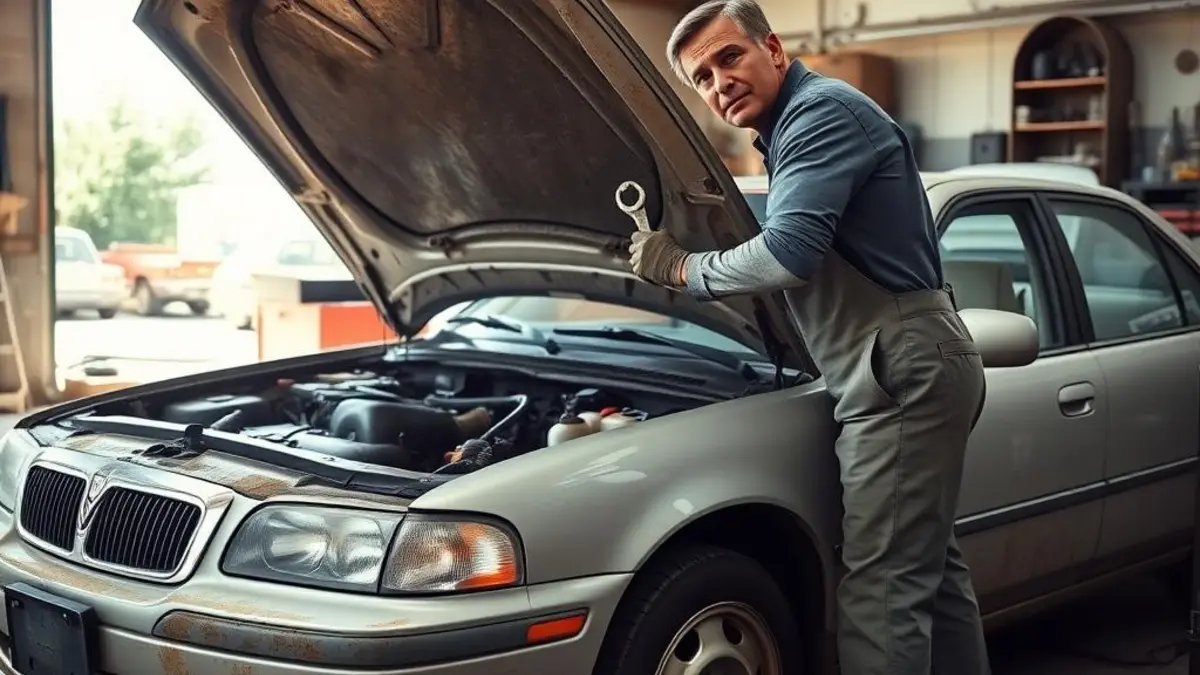Repair or Replace Your Car? Make the Smart Choice in 2025
Estimated reading time: 8 minutes
Facing the “repair or replace car calculator” dilemma with your vehicle can be one of the most stressful financial decisions.
Every strange noise or dashboard warning light forces you to question: Is this car worth fixing, or am I throwing good money after bad?
The repair or replace car calculator offers an objective way to make this difficult choice, helping you avoid the financial pitfalls of either premature replacement or endless costly repairs.
Making the wrong decision can cost thousands of dollars and create unnecessary stress. Let’s explore how to approach this repair vs replace decision with confidence and clarity.
Key Takeaways
- Recognizing when your car isn’t worth fixing can save you money and stress. Look for signs like the 50% rule, frequent repairs, or safety concerns.
- Using a repair or replace car calculator can provide an objective basis for your decision, removing emotional bias.
- Consider factors beyond just repair costs, such as your vehicle’s reliability, your personal needs, and potential future expenses.

Signs Your Car Isn’t Worth Fixing
Recognizing when your vehicle has reached its financial end-of-life is crucial. Here are the key car not worth fixing signs to watch for:
- The 50% Rule: When repair costs exceed half your car’s current market value, replacement typically makes more financial sense. This car repair cost threshold is a widely accepted benchmark among automotive experts. If you’re a new driver, unexpected car troubles can be particularly daunting. For tips on securing affordable coverage in such situations, check out this article: New Driver Insurance Hacks.
- Repair Frequency: If you’re visiting the mechanic monthly or your car spends more time in the shop than on the road, these recurring costs add up quickly.
- Safety Concerns: Older vehicles lack modern safety features. When critical safety systems like airbags, anti-lock brakes, or structural components begin failing, the risk outweighs the savings.
- High Mileage: Vehicles beyond 150,000 miles often experience cascading failures. Once you fix one system, another begins failing, creating a never-ending repair cycle.
- Diminishing Returns: When repair costs start approaching what you’d pay for a newer, more reliable vehicle, it’s time to consider replacement. This is the Right Tool for this type of problem.
The Repair or Replace Car Calculator: How It Works
The repair or replace car calculator eliminates guesswork from your decision-making process through simple, data-driven analysis. Here’s how it functions:
- Simple Inputs: Enter basic information about your vehicle:
- Current market value
- Estimated repair costs
- Vehicle age
- Current mileage
- Instant Analysis: The calculator processes these inputs against established financial thresholds and depreciation curves.
- Clear Recommendation: You receive a straightforward suggestion based on objective financial principles rather than emotional attachment.
Using this calculator brings several benefits:
- Emotional Distance: It removes the sentimental factors that often cloud judgment.
- Financial Clarity: You see the numbers laid out plainly.
- Long-Term Perspective: It accounts for future value and ongoing maintenance costs.
“One of the biggest advantages of using a repair or replace calculator is the peace of mind it provides. Knowing you’ve made a financially sound decision can reduce stress and allow you to focus on other important aspects of your life.”
Understanding Your Car’s Repair Cost Threshold
The car repair cost threshold concept helps determine if a repair makes financial sense. Here’s how to apply this principle to your situation:
The traditional guideline suggests that repairs costing 50-70% of your car’s value indicate it’s time to replace rather than repair. This percentage varies based on several factors:
- Newer Cars: Can justify higher repair percentages (up to 70%) because they have more useful life remaining.
- Older Vehicles: The threshold drops to 30% or even 20% for high-mileage cars because they’re more likely to develop additional problems.
Consider this real-world example: Facing a $2,000 transmission repair on a car valued at $3,000? That’s 67% of the car’s value, well above the recommended threshold. In this case, replacement likely makes more financial sense than repair.
Remember that this threshold should be cumulative. If you’ve already invested significantly in recent repairs, that history should factor into your current decision. To help make better decisions, consider using AI: Make better decisions with AI.
Key Factors in the Repair vs. Replace Decision
When wrestling with the repair vs replace decision, consider these critical elements:
Financial Considerations:
- Repair costs vs. current vehicle value
- Potential future repair needs
- New or used vehicle purchase costs
- Insurance premium differences
- Registration and tax implications
Vehicle Assessment:
- Current mileage and projected reliability
- Service history and maintenance records
- Known issues with your specific make/model/year
- Remaining useful life expectancy
Personal Factors:
- Is the current vehicle meeting your needs?
- Will a replacement vehicle require financing?
- How long do you plan to keep your next vehicle?
- Is your current vehicle paid off?
The question “is it worth fixing my car” depends on this complete picture, not just the immediate repair cost. Sometimes a $1,500 repair on a $4,000 car makes sense if the vehicle is otherwise reliable and meets your needs. When assessing your needs it’s ok to Saying no without guilt.
When Replacement Is the Smarter Choice
Certain situations clearly signal that replacement is the wiser option. Watch for these definitive car not worth fixing signs:
- Major Mechanical Failures: Engine or transmission replacements often cost $3,000-$7,000. Unless your vehicle is relatively new or of high value, these repairs rarely make economic sense. If you’re considering a new car, make sure compare plans so you know Best Medicare Advantage Plans 2025 (Healthcare).
- Financial Tipping Point: When your annual repair costs consistently exceed what monthly payments would be on a replacement vehicle, you’re losing money by keeping your current car.
- Safety Compromises: If structural integrity is compromised or critical safety systems are failing, no cost savings justify the increased risk to you and your passengers.
- Reliability Issues: When your vehicle regularly leaves you stranded or causes you to miss work, the hidden costs (towing, rideshares, lost wages) add up quickly.
Remember that the question “is it worth fixing my car” isn’t just about money. Your time, safety, and peace of mind have real value too.
“Don’t feel pressured to keep repairing a car that’s causing constant headaches and financial strain. Sometimes, moving on to a more reliable vehicle is the best decision for your overall well-being.”
Your Post-Calculator Action Plan
After using the repair or replace car calculator, take these strategic next steps:
- Compare Market Offers:
- Get instant online valuations for your vehicle in its current condition
- Request quotes from local dealerships
- Explore private sale options if your car has issues but remains drivable
- Get Detailed Repair Estimates:
- Obtain written quotes from multiple repair shops. But first: Avoid Being Scammed by Mechanics: How AI Can Help When You Don’t Know About Cars
- Request breakdown of parts vs. labor costs
- Ask about warranty coverage on major repairs
- Research Replacement Options:
- Check current market values before visiting dealerships
- Calculate total ownership costs, not just purchase price
- Consider certified pre-owned options with warranties
- Run the Numbers Again:
- With precise figures, revisit the repair or replace car calculator
- Factor in any financing costs for a replacement vehicle
- Consider seasonal timing (year-end sales, etc.)
This methodical approach ensures you’re making a decision based on complete information rather than pressure or emotion.
Conclusion
The repair or replace car calculator provides invaluable guidance when facing difficult automotive decisions. By objectively weighing your vehicle’s value against repair costs and considering factors like age, mileage, and reliability, you can make a financially sound choice that balances immediate needs with long-term value.
Remember these key principles from our discussion:
- The 50% repair threshold as a starting guideline
- The importance of considering cumulative repair history
- How age and mileage affect your decision threshold
- When safety concerns should override financial considerations
Take the guesswork out of your repair vs replace decision by using the calculator first, then following our recommended action plan. This approach transforms a stressful decision into a confident, data-driven choice that protects both your transportation needs and your financial well-being. Check out our lifestyle & curiosity hub guide.
FAQ
Q: When should I use a repair or replace car calculator?
A: Use a repair or replace car calculator when faced with a significant repair cost that’s causing you to question the financial viability of keeping your current vehicle.
Q:What factors does a repair or replace car calculator consider?
A: These calculators typically consider your vehicle’s current market value, estimated repair costs, age, mileage, and potential future maintenance expenses.
Q: Is the 50% rule always the best guideline?
A: While the 50% rule is a helpful starting point, it’s not always definitive. Consider other factors like your vehicle’s overall condition, reliability, and your personal needs.
-

 Best Picks10 months ago
Best Picks10 months agoDriving Insurance: Get the Best Car Coverage Without Overpaying
-

 Best Rewards3 months ago
Best Rewards3 months agoBest rewards credit cards in 2025 for everyday use
-

 Personal Growth & Mindset1 year ago
Personal Growth & Mindset1 year agoTed Lasso Effect: 5 Goal-Setting Secrets You Must Know
-

 Career & Success1 year ago
Career & Success1 year ago30 Key Strategies for Growth: Mindset, Productivity & Wellness
-

 Personal Growth & Mindset1 year ago
Personal Growth & Mindset1 year agoMachado de Assis: This Viral TikTok Explains Why You Need to Read ‘The Posthumous Memoirs of Brás Cubas’ Now
-

 Career & Success12 months ago
Career & Success12 months agoChallenges of Not Having Goals: 5 tips to help you get started









